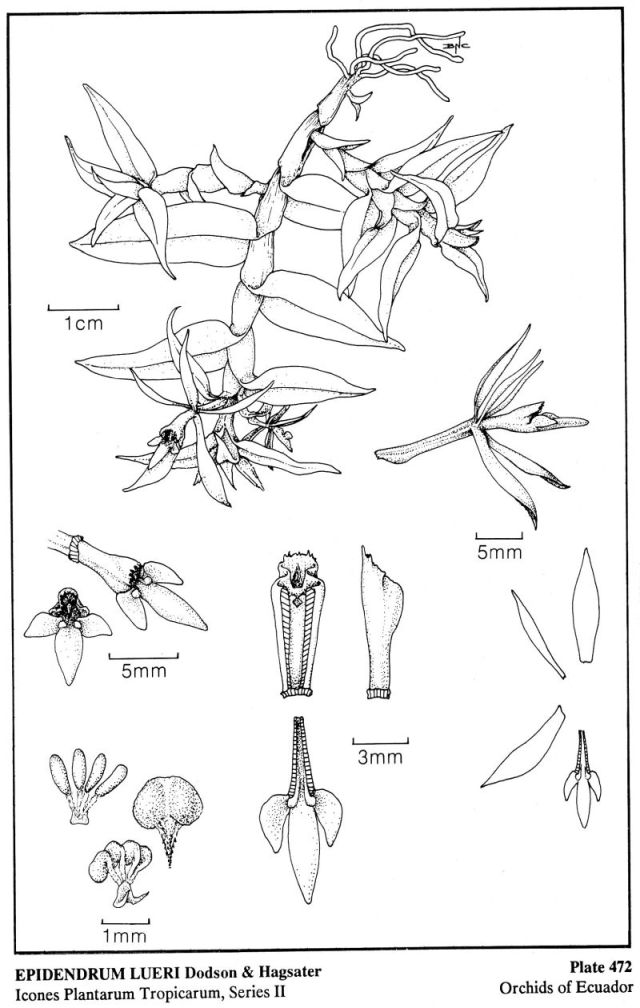

Epidendrum lueri Dodson & Hágsater 1989 GROUP Nanum
TYPE Drawing by © Dodson


 THROUGH MID
THROUGH MID 
Common Name Luer’s Epidendrum Orchid Enthusiast Pleurothallis expert, retired Physician and collector of species current]
Flower Size .6” [1.5 cm]
Found in southern Ecuador in very wet montane forests at elevations of 1000 to 1500 meters as a small sized, cool, pendent growing epiphyte with flattened, new stems arising from the middle internodes of the previous stem carrying 3 to 6, all along the stem, basaly twisted, narrowly ovate, acute leaves that blooms in the fall through mid winter on a terminal, fasciculate, alternate, 2 to 4 flowered inflorescence carrying small, pinkish yellow flowers with a bright yellow lip.
"Epidendrum lueri Hágsater & Dodson is part of GROUP Nanum and is recognized by the pendent stems, the stems branching, the short, terminal inflorescence carrying simultaneous flowers. Epidendrum madsenii Hágsater & Dodson is similar with the pendent stems Epidendrum whittenii has small, caespitose, recumbent plants, the leaves fleshy, all in one plane, with 3 apical, conduplicate, imbricating, prominent bracts, the flowers appear singly in succession and are rather large for the plant, white, with an orbicular lip, base cordate, with prominent, irregular keels. Epidendrum cuchibambae Lehm. & Kraenzl. also has large imbricating bracts at the base of the inflorescence, but the plant habit is different, with erect stems and leaves grass-like." Hagsater etal 1993
"Epidendrum lueri is also similar to Epidendrum jessupiorum but has a differently dentate clinandrium, shorter midlobe of the lip and a prominent front ornamentation of the anther. The species can be recognized by the small plants with single f1owers, the .24" [6 mm] sepals, 3-lobed lip, the fimbriate clinandrium and very prominent elongate vesicle on the underside of the ovary. It also seems close to Epidendrum nanum which has larger f1owers, the sepals being .32 to .44" [8 to 11 mm] long, a thinner vesicle and 1 to 3 flowered inflorescence. Epidendrum tingo-mariae Hágsater has an arched column with a prominent, erose clinandrium, green f1owers, with the anther also green, and a short nectary that does not penetrate further than the perianth. Epidendrum milenae Dodson & Vásquez, recorded from both Bolivia and Ecuador, and is to be expected in Peru, has green flowers with a prominent purple anther, straight column with a short, entire clinandrium. Epidendrum nanosimplex Hágsater & Dodson has a simple, entire lip, the vesicle of the ovary occupying about 1/3 of the ovary, and the entire clinandrium which slightly covers the anther. Epidendrum madsenii Hágsater & Dodson has a 3-lobed lip, a triangular, acute midlobe of the lip, a prominent dentate clinandrium, and the ornamentation of the anther consisting of a transverse, dentate process in front. Epidendrum macasense Hágsater & Dodson can be distinguished by the shorter, narrower leaves, the narrower petals, the unornamented anther, and the ovary which is not inflated and swollen into a vesicle at the base. In E. bonitense Hágsater & Dodson, the nectary does not reach the base of the ovary, the clinandrium is barely erose and the sepals are 4 to 5 veined, the midlobe of the lip is short-subquadrate and obtuse." Hagsater etal 2001
Synonyms
References W3 Tropicos, Kew Monocot list , IPNI ; *Icones Plantarum Tropicarum Plate 472 Dodson 1989 drawing fide; Icones Orchidacearum 2 Plate 155 Hagsater & Dodson 1993 see recognition section; Icones Orchidacearum 3 Plate 351 Hagsater & Sanchez 1999 see recognition section; Icones Orchidacearum 3 Plate 388 Hagsater 1999 see recognition section; Icones Orchidacearum 3 Plate 400 Hagsater 1999 see recognition section; Icones Orchidacearum 4 Plate 448 Hagsater 2001 see recognition section; Native Ecuadorian Orchids Vol 2 Dodson 2001 drawing fide;
--------------------------------------------------------------------------------------------------------------------------
--------------------------------------------------------------------------------